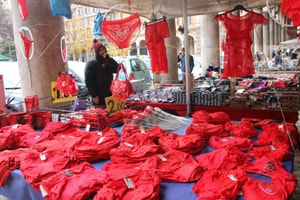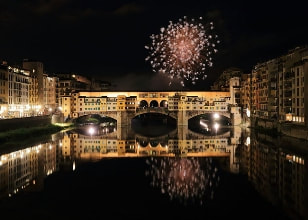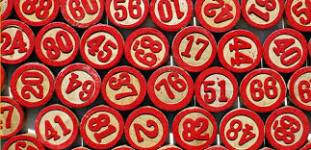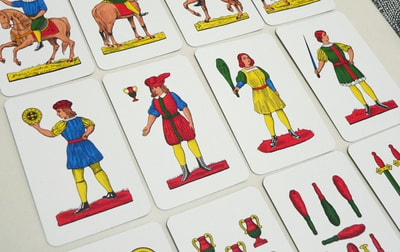Most cultures and countries celebrate the New Year (whenever it comes) by eating, drinking, celebrating, and often watching fireworks. They all tend to look at the New Year as a "new beginning" which they hope will bring good things (luck, health, fortune, love,) and good times in the coming year. They meet the day with anticipation and joy.
In Italy, December 31 is the Feast Day of San Silvestro, a saint who served as Pope from 314 to 335 and oversaw the conversion of Roman Emperor Constantine 1st's conversion to Christianity. Since the adoption of the Gregorian calendar, this day coincides with New Year's Eve and is the source of some of the Italian New Year's traditions, which are rife with symbolism.
So … what is it the Italians do to celebrate New Year's Eve?
EAT THE TRADITIONAL MEAL
Italians never miss a chance to celebrate an event with food, usually specialized for the kind of event. The nature of the specialty depends of the kinds of foodstuffs available at the time and location of the celebration and the local superstitions and beliefs. However, the New Year's Eve meal is very symbolic and well thought-out.
The traditional Italian New Year's meal features pork sausage [Cotechino] and lentils [lenticchie]. The meat is from the actual hoof of the pig [lo zampone] which is considered symbolic of abundance and bountifulness, apparent in the high fat content of the pork. This isn't just an Italian tradition. I imagine it comes from the time when pork could only be butchered in the winter.
The shape and color of the lentils reminds one of gold coins, thus representing money earned in the coming year. Thus, to the Italian way of thinking, the more you eat, the better off you'll be. Lentils are also long lasting and represent longevity.
The tradition of eating one spoonful of lentils for each sounding of the bell at midnight is rarely carried out these days, but has been translated into a different form by the Spanish.
While this belief has been around for back hundreds of years, the more recent tradition from Spain of eating 12 grapes in 12 seconds, one per each stroke of midnight dates back to the 1800's and had been adopted in many other countries. According to Judy Cantor-Navas on foodrepublic.com, "Eating the grapes pretty much guarantees starting off the year with a little adrenaline rush, and most likely some laughs. While the goal of getting the 12 grapes down in time can spark a contest of who is más macho around the table, the biggest challenge is more likely to be not gagging as you cram them in your mouth and try to swallow while laughing hysterically."
WEAR RED UNDERWEAR
Whether or not you have a date, both men and women wear red undergarments on New Year's Eve. This tradition apparently dates from early celebrations of the Feast Day of San Silvestro.
While red traditionally means, in many cultures, love, good fortune, and fertility, the color has been used for centuries to ward off war, disasters, evil spirits, and negativity, and has a more general meaning than good fortune in love or sexual endeavors, as most modern Italians believe.
Finally, tradition requires that these be thrown out the day after the party for the ritual to be effective. Maybe that's why one sees vast displays of cheap red underwear between Christmas and New Year.
THROW THE OLD OUT THE WINDOW
It's a bird. It's a plane. It's a unidentified falling object! It's New Year's Eve in Italy.
The first New Year's Eve I experienced in Rome in 1963, I was surprised to learn you couldn't be on the streets from about 11 p.m. and 2 a.m. because it was traditional for people to throw out old possessions, particularly crockery but even furniture, out of the windows. Apparently, in southern Italy that was considered symbolic for getting rid of the getting old to welcome in the new year. Porbably elsewhere as well.
Since most of the apartment buildings in old Rome were four to six stories high, that could be a lot of debris and deadly for anyone on the sidewalk. The people who owned cars in those days, had to park them off the streets in protected locations. Around 3 a.m. a fleet of street sweepers [men with brooms, not machines] flooded the areas of Rome popular for parties, and began sweeping up the trash. Even years later, when the populace stopped throwing out so much of the heavy stuff, they would still throw out champagne bottles [spumante, in Italy] which can do almost as much damage to a skull.
SMASH PLATES
Smashing plates, glasses, and other glass and pottery items against the ground is another tradition to drive away bad omens which might contaminate the coming year. Since throwing things out the window is related to southern Italy, perhaps this accomplishes the same thing for other Italians.
Watching fireworks is not exclusive to Italians or invented by them, but they go in for the big bangs. It's very dramatic to see fireworks light the skies above ancient monuments, but there's a purpose to their madness. Superstition has it that demons and negative spirits don't like loud noises. Fireworks ensure that, in addition to entertaining the revelers with awe-inspiring sights, the bad spirits are gone before the new year begins.
PLAY CARDS ALL NIGHT
Even at the most trendy New Year's Eve parties, many of the guests of all ages will spend the entire night playing cards or tombola, a game similar to bingo. Tombola originated in Naples in the 1700s to get around gambling, which the church frowned on. As a concession to the church, King Charles of Naples banned gambling during the Christmas period, but the Neopolitans got around the law by playing bingo at home. Another card game popular in the south is Scopa.
CONFRONT THE FUTURE
Italians love superstitions. New Year’s superstition foresees the first person you meet after midnight on New Year is the person who establishes what kind of year you will have. Meeting someone older of the opposite sex means you will have a great year because this is a sign you will live a long life and be lucky in love. Avoid seeing a baby or someone of the same sex. This is not the best start for the year.
Variations of the omen cautions Italians to avoid meeting a doctor first, because it means your health will deteriorate. Seeing a priest or a postman are also bad omens, although I didn’t find an explanation. From my own experience with my husband’s Italian family, I’d say it means someone will die or at least you’ll be getting some bad news.
BANG ON OLD POTS AND PANS
This action is supposed to exorcise previous bad luck and evil spirits. This, along with throwing old things out the window and smashing crockery, symbolizes an attitude of letting go of unhappiness in preparation for a better, more promising future. Wear a crash helmet.
“Out with the old …”
Exchanging gifts is considered lucky. Favored items include sweets, jars of honey, gold or silver items, money and coins, as well as lamps. The sweets and honey signify peace and the sweetness of life, precious metals and currency invoke prosperity, and lamps are thought to bring light (good fortune, happiness, wisdom, and so on) into one’s life for the next year.
In some places such as Naples, however, this custom can differ slightly, and instead of the items mentioned, they use figs wrapped in bay leaves. This is an echo of an ancient Roman tradition of exchanging jars of figs and dates in honey, together with a bay branch, for good luck.
LIGHT THE YULE LOG
Yet another way to drive evil spirits away is to light the Yule log on the last day of the year. Its flames are believed to scare away any malevolent spirit, and it is also a gesture of inviting the Virgin Mary into your home, where she can warm the infant Jesus near the fire. After the log has burned out, the ashes are then collected and used as charms to protect the home from various types of damage.
FINALLY, GO JUMP … IN THE TIBER
A more recent tradition -- for a very few but growing number of people -- is to jump off the one of Rome’s many bridges into the Tiber River. The very cold Tiber River.
In the photos, brave Italians jump from the Cavour Bridge, which serves as a traditional New Year celebration which dates back to 1946, in Rome, capital of Italy.
Happy New Year! See you in January, 2018.
Resources
https://www.buzzfeed.com/conzpreti/the-weirdest-new-years-eve-traditions-from-around-the-world?utm_term=.avAX9xW5y#.trB24Km07
https://selectitaly.com/blog/all-you-can-italy/new-years-eve-traditions/
http://www.thelocal.it/20151231/italian-new-year-traditions-and-superstitions
http://www.123newyear.com/newyear-traditions/italian.html
http://www.italymagazine.com/featured-story/new-years-eve-italian-traditions
https://www.touritalynow.com/blog/buon-anno-italian-new-years-eve-customs/






















 RSS Feed
RSS Feed